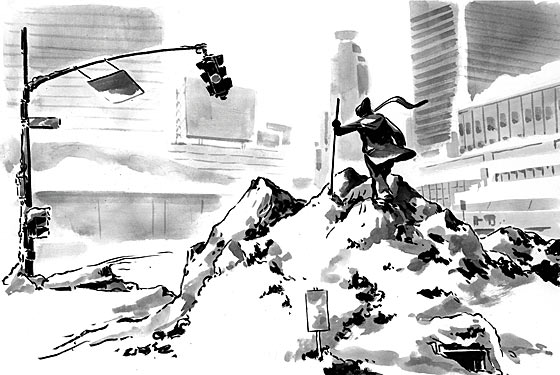
At the rotten end of a month in which the city seemed besieged by winter, when we were being by turns pummeled, walloped, slammed, and blasted by a string of snowpocalypses, snowmageddons, and tsnownamis—amid all this, Harvard economist Edward Glaeser walks into P.J. Bernstein restaurant on Third Avenue on a snowy morning before those two other, snowier mornings and, of all things, smiles.
“It’s tough! There’s no question it’s tough,” he says. “It’s a handicap all northern cities have.” He would know. Glaeser’s new book, Triumph of the City, is a probing look at what makes and breaks cities—which, Glaeser argues, represent the pinnacle of human achievement and the best hope for the future of the species. It is a vindicating read for urbanites forever grinding their teeth at the blinkered hillbilly logic behind statements like “the best of America is in the small towns” (S. Palin), and “the growth of the nation depends not on cities but [on] its villages” (M. Gandhi). Not so, Glaeser makes clear. People in U.S. cities tend to live longer and are far more productive than non-city-dwellers.
Yet among all this data, one finding jumps out, particularly right now: The single variable that best predicts a U.S. city’s growth over the past century is its average January temperature. Hence the decline of many northern and midwestern cities and the boom in the South and the Sun Belt, where the Phoenix, Atlanta, Houston, and Dallas metropolitan areas have each gained a million people since 2000. For every five degrees that a city’s January temperatures top the national average, Glaeser writes, its real-estate prices will beat the national mean by 3 percent, thanks to the increased demand.
New York bucks the trend because it offers more than enough benefits to offset its winters (there are no available stats on any countereffect the annual summertime garbage miasma might have). A deeply ingrained culture of entrepreneurship keeps the city’s economy in a perpetual state of creative renewal, and recessionary dips notwithstanding, job opportunities abound: There are more people employed in the five Zip Codes between 41st and 59th Streets in Manhattan than in New Hampshire or Maine, with a combined annual payroll larger than Oregon’s or Nevada’s. And, of course, there’s the fact that New York is a flat-out good time.
But the amenities that make it so also have side effects: “Twenty-first century New York is a playground for the prosperous,” Glaeser writes. And it’s here that Triumph of the City provokes a tinge of ambivalence. New York has triumphed indeed since its Thunderdome days, but in the process it has become more and more a gentrified consumer city. From 1998 to 2007, the number of people working in Manhattan restaurants increased by 44 percent, for instance, and the number of employees working in clothing and accessory stores jumped by 50 percent. We’re not talking about Dressbarns here. “While most of America is a service economy that caters to the middle classes,” writes Glaeser, “Manhattan’s salespeople serve the urban haute bourgeoisie.”
So we’re conflicted. We like a sophisticated town, but at the same time, our collective identity as New Yorkers is tied up with the belief that living here takes a certain toughness. A city awash in luxe clothing and startlingly overpriced baked goods (made, per the new standard, with organic butter hand-churned in a reclaimed factory in Gowanus) plays to the effete caricature that so delights flyover country.
And it’s for that backdoor reason that we shouldn’t be grousing about the weather. We should welcome it, lord it over those so soft that they need to flee to warmer climes. Yes, this big, bad city isn’t as bad as it once was, but it still demands some of the old resiliency. Ours is definitely an embarrassment of riches, but we’ll always have January.
Have good intel? Send tips to intel@nymag.com.